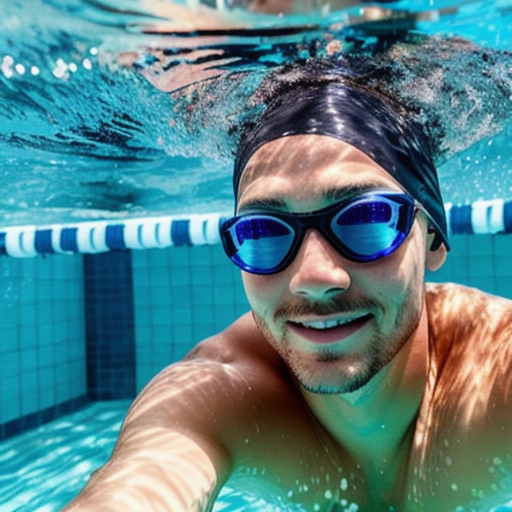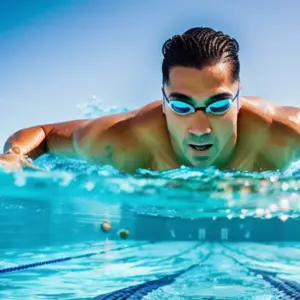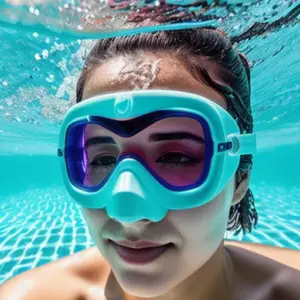Do you find yourself squinting at the swimming line just a few feet away and longing for the days when you could glide effortlessly through the water, without worrying about losing your precious contact lenses or damaging your expensive prescription goggles? If you’ve recently opted for LASIK eye surgery, you’re probably eager for that dive into crystal-clear vision, literally! But, as with all things related to your precious peepers, you can’t just cannonball back into your favorite aquatic activities without a second thought. If you, too, are wondering, “how long after LASIK can I go swimming?”, then you’ve come to the right place. We’re here to give you the lowdown on post-LASIK swimming advice, so that you can take the plunge with peace of mind and have optimal healing for your newly improved eyesight—because we all know you’ve only just begun to see the true beauty of the world through your laser-corrected eyes!
Introduction to swimming after LASIK
Swimming after LASIK can be an enticing prospect, especially for those who have been dependent on glasses or contact lenses for enjoying water-based activities. Imagine the freedom of diving into a pool or swimming in the ocean without worrying about losing a contact lens or dealing with foggy swim goggles. While LASIK is a minimally invasive surgery with a light recovery process, it is crucial to follow proper guidelines to ensure optimal recovery and avoid any complications. In this article, we will briefly discuss the recommended timeline for swimming and other water-related activities after undergoing LASIK surgery.
The LASIK procedure reshapes the cornea to correct refractive errors, enabling patients to experience clear vision without the aid of glasses or contact lenses. One of the most critical aspects of LASIK recovery is avoiding contact sports and physical athletic activities, including swimming, for a specific duration. Your eyes are more vulnerable to irritation and infection in the weeks following LASIK, so it is essential not to jump in the water too soon.
Here is a general timeline for swimming after LASIK surgery:
– After 2-4 weeks: You can swim in a chlorinated pool, but make sure to wear protective goggles to keep your eyes safe from the chemicals.
– After 4-8 weeks: You can swim in natural bodies of water such as lakes, rivers, and oceans, as well as indulge in low-impact water sports like kayaking and snorkeling. Remember to continue wearing goggles while swimming.
– After 8-12 weeks: High-impact water sports such as water polo can be resumed, provided you still use protective goggles.
-After 12 weeks onwards: Finally, you can swim without goggles and open your eyes underwater without fear of complications.
Throughout your recovery, be sure to wear UV sunglasses when outdoors, particularly in the first six weeks following LASIK. This simple precaution will help protect your eyes and ensure a smooth, complication-free recovery as you return to your favorite water-based activities.

Benefits of LASIK
LASIK (Laser-Assisted in Situ Keratomileusis) is a popular and effective vision correction procedure that reshapes the cornea to improve nearsightedness, farsightedness, and astigmatism. Many people, especially athletes and swimming enthusiasts, opt for this treatment due to the numerous benefits it provides. Below are some of the top advantages of LASIK.
1. Improved Lifestyle: One of the main benefits of LASIK is the freedom from depending on glasses or contact lenses. Post LASIK, people can engage in activities like swimming, hiking, or playing sports without any worries about losing their glasses or having contact lens irritation.
2. Better Vision: LASIK offers a high success rate with most patients achieving 20/20 vision or better. This improved visual clarity allows individuals to appreciate the finer details of life, without any blurs or distortions.
3. Increased Confidence: LASIK can boost self-esteem as people become less dependent on corrective eyewear. The procedure typically results in a greater sense of independence, leading to higher confidence levels in daily life.
4. Quick Recovery: LASIK surgery is relatively quick, and the recovery process is typically swift. Generally, patients can return to work and resume their daily activities within 24 hours following the procedure.
5. Long-lasting Results: The results of a successful LASIK surgery are long-lasting. Although the patient’s eyes may still undergo changes due to aging, the need for corrective lenses is minimized, ensuring years of clear vision.
LASIK is an excellent option for those looking to improve their vision and enjoy a glasses-free lifestyle. The benefits, including enhanced vision clarity, increased confidence, quick recovery, and long-lasting results, make this procedure a popular choice for many. However, it is essential to consult an experienced eye surgeon to ensure that LASIK is the right option for the individual’s specific needs.
Minimally invasive LASIK surgery and quick recovery
LASIK (Laser-Assisted in Situ Keratomileusis) surgery has gained immense popularity as a reliable solution for various vision problems such as near-sightedness, far-sightedness, and astigmatism. One of the significant advantages of this minimally invasive procedure is its quick recovery time, which allows patients to resume normal activities within a short period.
During the LASIK procedure, a thin flap is created on the cornea which is then lifted to allow the excimer laser to reshape the eye’s underlying tissue. Once the reshaping is completed, the corneal flap is put back in place, allowing it to heal naturally. This enables the cornea to focus light accurately on the retina, resulting in sharp, clear images and improved vision.
Post-surgery, patients usually experience a swift recovery. Many are able to drive and resume work the very next day, with most of the healing occurring during the first week itself. However, specific activities like swimming or engaging in contact sports should be avoided in the initial weeks following the surgery to prevent complications.
In general, patients are advised to stay away from swimming pools and natural water bodies for at least two weeks post-surgery, as the water may contain chlorine or microorganisms that could irritate or infect the sensitive eyes. Wearing well-fitting goggles when swimming is highly recommended during the initial four to five weeks. After six weeks, most patients can safely engage in water activities without any worries.
To ensure a smooth recovery, it is essential to follow the surgeon’s post-operative guidelines, wear sunglasses when outdoors, and stay hydrated. By taking these precautionary measures, patients can enjoy the benefits of their minimally invasive LASIK surgery and get back to their daily lives with improved vision in no time.
Avoiding physical activities during LASIK recovery
Importance of Rest During LASIK Recovery
Undergoing LASIK eye surgery comes with a relatively quick recovery time, allowing most patients to return to work and certain activities the day after their surgery. However, it is essential for patients to avoid engaging in physically demanding activities during the initial recovery period. This ensures that the eyes can heal properly without any complications, such as increased risk of infection or irritation. To maximize the benefits of the procedure, patients must take a short break from strenuous activities and follow their doctor’s guidelines for a speedy and successful recovery.
Swimming and Water Activities
Specifically, swimming and engaging in water sports should be avoided in the weeks following LASIK surgery due to the increased risk of infection and irritation. For swimmers, it is recommended that they refrain from swimming for at least two weeks, as water in pools, lakes, rivers, and oceans can introduce harmful bacteria and irritants to the sensitive, healing eyes. Additionally, protective goggles should be worn when resuming water activities to further reduce the risk of complications.
Contact Sports and Exercise
Similarly, patients recovering from LASIK surgery should avoid contact sports and high-impact exercises for at least a month. These activities pose a higher risk of injury to the eyes, which can hinder the healing process or even displace the corneal flap. When resuming such activities, wearing protective eyewear is crucial to ensure the safety of the eyes.
Gradually Resuming Physical Activities
While patients should avoid strenuous physical activities during the initial recovery period, they may slowly and cautiously reintroduce these activities into their routine once their doctor has given them clearance. Listening to one’s body and closely monitoring eye health while resuming activities is critical for a successful LASIK recovery. It is essential for patients to consult their doctor for personalized recommendations and guidelines to ensure their eyes heal correctly and they can fully enjoy the benefits of the procedure.
Chlorinated pools and their effect on post-LASIK eyes
Chlorinated pools are a common place for individuals to swim and cool off during hot summer months, offering a refreshing escape without the additional concerns of bacteria or irritants found in natural bodies of water. However, for those who have recently undergone LASIK eye surgery, diving into a chlorinated pool without proper precautions can pose potential risks to the healing process.
Following LASIK surgery, it is recommended to avoid swimming activities for at least a week, while some experts suggest waiting up to two weeks before swimming in a chlorinated pool or any other body of water. During the initial healing period, the eyes are more sensitive and vulnerable, with a higher risk of infection or irritation that can hinder the overall recovery process.
Chlorinated pools are designed to be disinfected and generally safer compared to natural bodies of water in terms of bacteria levels. Despite this advantage, the chemicals present in the water can still cause irritations and potentially damage the delicate tear film of the eyes. Therefore, it is essential for individuals who have recently undergone LASIK surgery to wear goggles when swimming in any chlorinated pool, particularly during the initial weeks of recovery.
Wearing goggles protects the eyes from direct contact with chlorinated water and other potential irritants, such as sunscreen or other swimmers’ debris. In addition to goggles, it’s essential for those who have had LASIK surgery to ensure proper eye care and protection during the healing process, such as avoiding rubbing the eyes and taking care to use UV sunglasses when outdoors.
While chlorinated pools have their benefits in terms of hygiene and disinfection, post-LASIK patients must take extra precautions to protect their delicate eyes during the healing process. By following expert guidance, such as wearing goggles and avoiding swimming activities for at least a week to two weeks, individuals can enjoy a safe and successful recovery with clear vision in the long term.
Swimmable natural bodies of water after LASIK
LASIK eye surgery is a popular vision correction procedure that is quick, easy, and provides patients with clearer vision. After undergoing LASIK, many individuals look forward to engaging in various water activities without the need for glasses or contact lenses. While swimming is an enjoyable way to have fun and exercise, it is essential to remember that post-operative care plays a crucial role in ensuring optimal healing and better results from the LASIK surgery.
One vital consideration for patients after LASIK is regarding swimming in natural bodies of water, such as lakes, rivers, and oceans. Since these open water areas may harbor significant levels of bacteria, dirt, and sand, it is generally advised that patients wait for at least three weeks after the procedure before venturing into these water sources. To minimize the risk of infection and irritation, wearing protective goggles is highly recommended for the initial swims in natural bodies of water.
Approximately four to five weeks post-surgery, most patients should have sufficiently healed eyes and may choose to swim without goggles, both in swimming pools and natural water bodies. However, it is essential to note that individual healing times may vary, and consulting with the surgeon or their staff is always the best approach to determine the appropriate timeframe for each patient.
While LASIK eye surgery offers newfound freedom to enjoy water activities, it is crucial to follow post-operative care guidelines, particularly concerning swimming in natural bodies of water. By taking proper precautions and allowing sufficient healing time before diving in, patients can have a safe and pleasant experience while enjoying their improved vision.
Timeline for post-LASIK swimming
After undergoing LASIK eye surgery, many patients look forward to enjoying various water activities with clear vision and without worrying about glasses or contacts. However, it is important to follow a specific timeline for post-LASIK swimming to ensure proper healing and avoid complications. Here is a general guide on when you can resume different water activities after your LASIK procedure:
1. Showering and bathing: You can shower and bathe immediately after your LASIK surgery, but you must be extra careful not to get soap, shampoo, or water into your eyes. Avoid rubbing your eyes with a towel when drying off.
2. Swimming in chlorinated pools: You should wait at least two weeks before swimming in a chlorinated pool. Remember to wear goggles to protect your eyes from the chlorine and potential irritation.
3. Sitting in hot tubs and swimming in natural bodies of water: After two weeks, you can also sit in hot tubs and swim in natural bodies of water such as lakes, rivers, and oceans. However, it is recommended to wear goggles as a precaution against bacteria, dirt, and sand particles that might irritate your eyes.
4. Engaging in low-impact water sports: After two weeks, you can resume low-impact water sports like kayaking and snorkeling. Goggles should still be worn to protect your eyes.
5. Participating in high-impact water activities: After one month, you can engage in high-impact water sports like water polo, but remember to wear protective goggles.
6. Swimming without goggles and opening your eyes underwater: You can safely swim without goggles and open your eyes underwater after one month post-LASIK. However, it is still a good practice to wear goggles when swimming in natural bodies of water or engaging in more intense water sports.
Following this timeline for post-LASIK swimming and taking necessary precautions will ensure that your eyes heal properly and that you can enjoy various water activities with your improved vision.
Water restrictions during LASIK recovery
LASIK eye surgery is a popular and effective procedure that provides patients with crystal-clear vision. However, it’s essential to follow the recommended water restrictions during the recovery period to ensure proper healing and avoid potential complications.
One of the main concerns after LASIK is the vulnerability of the eyes to irritation and infection. In the first two weeks after surgery, patients should avoid swimming in chlorinated pools, hot tubs, and natural bodies of water such as lakes, rivers, and oceans. Chlorine and other chemicals can irritate the healing eyes, while bacteria and dirt can cause infections, leading to potential complications.
Showering and bathing can be resumed immediately after surgery, but with caution. Patients should take care not to get water, shampoo, or soap in their eyes during the healing process. When drying off, gently patting the eye area is advised, avoiding rubbing the eyes with a towel.
After the initial two-week recovery period, patients can resume swimming in chlorinated pools, wearing protective goggles to shield their eyes from irritation. Similarly, engaging in low-impact water sports such as kayaking and snorkeling is allowed by wearing goggles as well. High-impact water sports like water polo should also be resumed with protective goggles on for added safety.
Finally, after approximately one month of recovery, patients can fully enjoy swimming without goggles and opening their eyes underwater. However, wearing UV sunglasses when outdoors, especially during the first six weeks after surgery, is still highly recommended to protect the eyes from harmful ultraviolet rays.
In conclusion, following the recommended water restrictions during LASIK recovery is crucial in ensuring the eyes heal properly, avoiding complications, irritation, and infection. Patients can gradually return to their favorite water activities with proper care and precautions.
Showering and swimming after LASIK
LASIK (Laser-Assisted in situ Keratomileusis) is a popular refractive eye surgery that allows patients to enjoy clear vision without glasses or contact lenses. After the procedure, many people look forward to engaging in activities like swimming and showering without the hassle of prescription eyewear or contacts. However, it’s essential to follow post-operative guidelines to ensure a safe and speedy recovery.
Showering after LASIK
Patients can resume normal showering and bathing routines the day after their LASIK surgery. It’s crucial to avoid getting soap, shampoo, or water in the eyes, as this may cause irritation. Be gentle when drying the eyes; pat them instead of rubbing to prevent any harm to the healing cornea. Protecting your eyes as they recover from surgery is essential to avoid complications and ensure optimal results.
Swimming after LASIK
Swimming after LASIK requires more caution and a longer waiting period. Generally, it’s safe to swim in chlorinated pools two to four weeks after surgery, but patients should wear goggles at all times to protect their eyes from water-borne irritants and microbes. For natural bodies of water like lakes, rivers, or oceans, it is advisable to wait for at least three weeks before swimming, and goggles should still be worn. Approximately four to five weeks after LASIK, patients can swim without goggles, but it’s essential to follow your surgeon’s recommendations and consider their advice on individual healing progress.
Protecting your eyes
In the weeks following LASIK surgery, it’s essential to wear UV-protective sunglasses whenever exposed to sunlight, reducing the risk of damage and complications. Moreover, making a habit of wearing sunglasses and using goggles while swimming can prevent exposure to harmful UV rays and water-borne irritants long term.
While showering can resume shortly after LASIK surgery, swimming requires more caution and a longer healing time. Always follow post-operative guidelines provided by your surgeon to ensure your eyes heal properly, allowing you to enjoy the benefits of clear vision.
Consultation with LASIK surgeon before swimming post-surgery
As exciting as it may be to imagine swimming without the hassle of glasses or contacts, it is essential to follow your LASIK surgeon’s recommendations for swimming post-surgery. It is crucial to protect your eyes and ensure proper healing. While recovering from LASIK is typically a smooth and quick process, every patient’s healing timeline may vary. Consulting with your LASIK surgeon is the best way to know when you can safely enjoy water activities.
In general, LASIK patients should avoid chlorinated pools for two to four weeks after surgery and natural bodies of water like rivers, lakes, and oceans for up to eight weeks. The reason for these precautions is that water can contain harmful organisms, chemicals, and foreign particles that may damage the delicate healing process of the cornea.
Once your surgeon gives the go-ahead, you may resume water sports and swimming with protective goggles. This includes activities like snorkeling, surfing, and even scuba diving. It is important to note that concerns about the pressure from diving affecting a post-LASIK eye are largely unfounded; in fact, even Navy SEALs who have undergone corrective procedures can go back to diving without issue.




